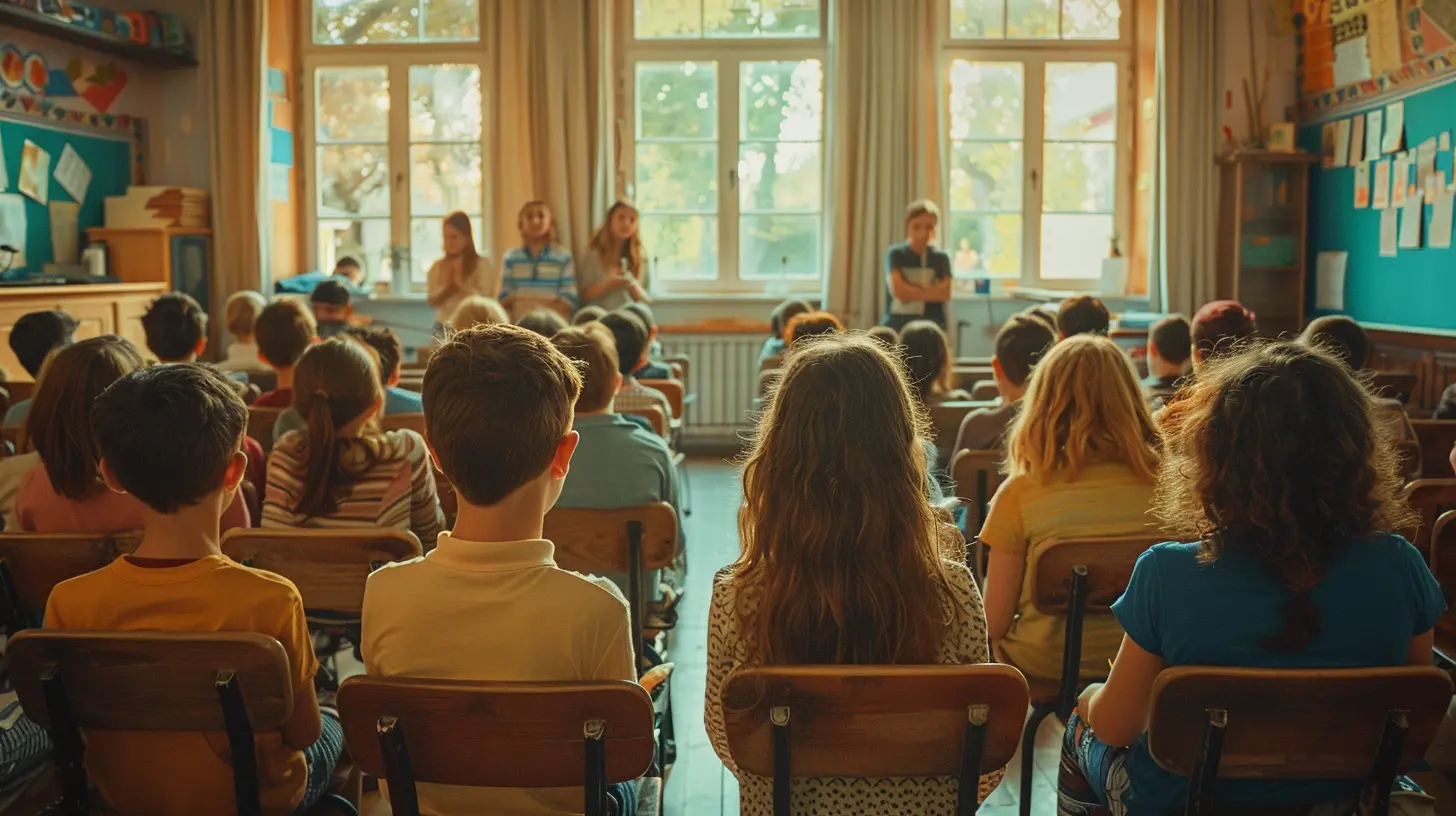Creating a Cohesive School Vision: Collaborative Leadership in Action
16 July 2025
Have you ever watched a flock of birds dance across the sky in perfect unison? It’s like magic—the way they weave and swoop together, every wingbeat aligned. That kind of harmony doesn’t happen by accident. It takes instinct, awareness, and—most importantly—connection.
In a lot of ways, a school isn’t all that different. When every part—teachers, students, administrators, families—moves together toward a shared goal, the result can be just as breathtaking.
That’s the heart of a strong school vision.
Let’s dive deep into what it really means to create a cohesive school vision. Not the dusty statement on the website that no one remembers, but a living, breathing mission that pulses through every hallway. And more importantly, let’s talk about the unsung hero behind it all: collaborative leadership.

What Is a School Vision, Really?
Imagine starting a journey without a destination. You wouldn’t pack your bags, hop in the car, and just drive without knowing where you're headed, right?A school vision is that destination—a clear, vibrant picture of what the school strives to become. It’s the “why” behind every lesson plan, every staff meeting, every decision.
A Living Declaration
The best school visions aren’t just crafted and forgotten; they’re revisited, refined, and rallied around. They reflect the values of the community—the dreams of the students, the hopes of the teachers, and the aspirations of the parents.They’re alive.
And when a vision pulses at the core of a school, it becomes the compass for daily decisions, shaping everything from behavior policies to budget plans.

Why Cohesion Matters
You can have a vision—but if no one’s on board? It's nothing more than fancy wallpaper.Cohesion means alignment. It means every stakeholder, from the cafeteria staff to the principal, knows the destination and believes in getting there.
Let’s be real: schools are full of moving parts. Different personalities, perspectives, and pressures. Without a cohesive vision, those parts pull in different directions. With one? They move like that flock of birds—beautifully, purposefully, together.
The Pitfalls of a Fragmented Vision
Disjointed visions often lead to:- Confusion around goals
- Inconsistent teaching strategies
- Misaligned policies
- Low morale among staff and students
- Parental frustration
Unified visions, on the other hand, foster trust, direction, and a strong school culture. It’s the difference between paddling upstream and cruising with the current.

So... Who Creates the Vision?
Here’s a trick question: Is it the principal’s job to create the vision?Well, yes. But also… no.
Enter Collaborative Leadership
True vision-building isn’t a solo act. It’s a jam session—a collaboration between everyone who has a stake in the school’s success.Sure, traditional leadership might come from the top down. But collaborative leadership? That flows in every direction.
It invites people in. It says, “Hey, what do you care about? What do you think our students need to thrive?” It means teachers, students, parents—even community members—have a voice.
Like a group of musicians tuning their instruments, each person brings something different to the table. And when they play in sync? That’s when the magic happens.
The 5 Pillars of Collaborative Leadership in Vision Building
Let’s break down how collaborative leadership actually works on the ground level. Think of this as your blueprint for building—and living—a cohesive school vision.1. Huddle Up and Listen
Before you ink a single word on that vision statement, listen.Hold vision workshops. Host listening sessions. Send out anonymous surveys. This is your chance to ask:
- What do we stand for?
- What do we want our students to become?
- What’s working here—and what’s not?
The goal? Capture a kaleidoscope of perspectives. Because everyone sees the school through a different lens, and that’s a good thing.
When people feel heard, they feel valued. And when they feel valued, they show up.
2. Define Core Values Together
Every strong vision rests on a bedrock of shared values.Maybe you value equity. Maybe innovation. Kindness. Academic excellence. Community service.
Let your team define these together. Circle up in staff meetings. Break into focus groups. Hang giant sticky notes on the walls and go to town.
When the whole school defines what matters most, those values become personal. They mean something. And they start showing up in the everyday.
3. Co-Create the Vision Statement
Now it’s time to put pen to paper.But resist the urge to get too formal or fancy. This isn’t about sounding impressive. It’s about being authentic.
Involve everyone in the drafting process—even students. Especially students. After all, they’re the heartbeat of the school.
Keep it short, sweet, and packed with punch.
A vision like: “Empowering every learner to lead with courage, curiosity, and compassion.”
Speaks volumes more than: “To establish a 21st-century learning environment through the development of core competencies and structured assessment measures…”
You get the point.
4. Lead by Living It
Once you have your vision, now comes the real test: living it out.Leadership here isn’t just about job titles. It’s about modeling the values day in and day out.
If your vision values collaboration? Foster team teaching.
If it champions equity? Audit your curriculum for bias.
If it highlights community? Get your school involved in local initiatives.
Actions make the vision real. Every hallway conversation, every staff meeting, every classroom interaction—these are the moments that either bring the vision to life or leave it gathering dust.
5. Keep It Fluid
Here’s the thing: your school isn’t a snapshot. It’s a motion picture.Communities change. Students grow. Challenges evolve.
That means the vision should be revisited regularly. Not to overhaul the whole thing, but to check the pulse. Are we still headed where we want to go? Do our values still reflect who we are now?
Staying flexible doesn’t mean being flaky. It means being responsive.
Building Trust Through Transparency
Let’s talk about trust. Because without it? Collaborative leadership collapses.Transparency builds trust. And trust builds teams.
Share the visioning process openly. Celebrate the milestones. Acknowledge the bumps along the road. When people understand the “why” behind decisions, they’re far more likely to stay engaged.
Let stakeholders see themselves reflected in the vision. That’s how you turn passive participants into active champions.
Empowering Voices at Every Level
Want to really make your vision stick? Empower others to lead.- Let teachers take the lead on projects aligned with the vision.
- Set up student leadership teams.
- Involve parents in action planning.
Leadership isn’t about permission—it’s about empowerment.
When everyone sees themselves as part of the mission, the vision becomes more than a document. It becomes a movement.
Case In Point: A Snapshot of Cohesion
Let’s say there’s a middle school that decides to center its vision around “creating passionate, life-long learners who lead with empathy.”Through collaborative leadership:
- Teachers co-design interdisciplinary projects.
- A student leadership council hosts empathy workshops.
- Parents volunteer in classrooms focused on service learning.
- Admins provide regular PD on emotional intelligence and inclusive teaching.
The result? A school where the spirit of the vision shows up in every corner. Not just on posters—but in practice.
That’s the power of cohesion—and collaboration.
The Ripple Effect of a Cohesive Vision
Here’s what happens when schools align around a shared vision:- Students thrive: They experience consistency, belonging, and purpose.
- Staff unify: Decisions feel congruent. Morale improves.
- Families engage: They believe in the “why” behind the school’s work.
- Leaders lead joyfully: Because they’re not dragging the cart alone.
It’s not always perfect. But it’s powerful.
And just like that flock of birds, when everyone knows where they’re headed—there’s grace in the journey.
Final Thoughts: Your Vision, Your Flight Plan
Creating a cohesive school vision isn’t just a leadership task. It’s a community-wide commitment to move together, speak together, dream together.It takes time. It takes trust. It takes collaboration that’s authentic, not superficial.
But when done right? It transforms schools from places of routine to spaces of purpose.
So gather your birds. Tune your instruments.
And let your school’s vision take flight.
all images in this post were generated using AI tools
Category:
Leadership SkillsAuthor:

Anita Harmon
Discussion
rate this article
1 comments
Benjamin Wyatt
Great insights on collaborative leadership! Fostering open communication among stakeholders is vital for developing a cohesive school vision that truly reflects community values.
August 13, 2025 at 2:40 AM

Anita Harmon
Thank you! I completely agree—open communication is essential for aligning our school vision with community values.


